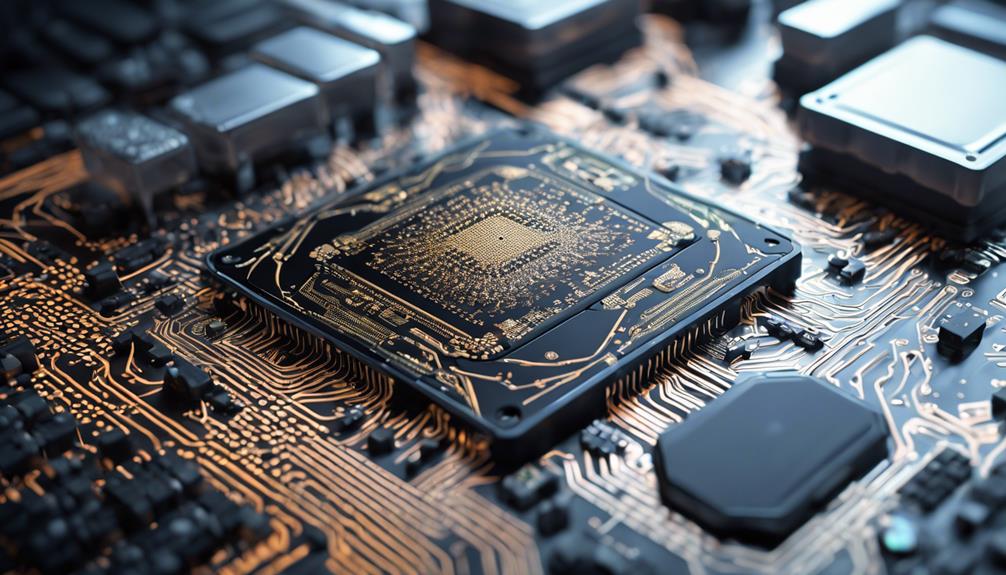As we navigate the intricate web of technological advancements, we are now standing at a crucial crossroads influenced by the intricate relationship between autonomous AI and advancements in chip technology.
The fusion of these two pillars of progress holds the key to unlocking a realm of possibilities yet to be fully explored.
The intricate interplay between artificial intelligence and semiconductor technologies not only shapes the landscape of innovation but also redefines the very essence of technological evolution.
Stay tuned to uncover how this symbiotic relationship is reshaping our tomorrow, propelling us into uncharted territories of growth and discovery.
Key Takeaways
- Sovereign AI concept crucial for national autonomy in AI development.
- Chip innovations drive AI progress and new industrial revolution.
- Investment in AI hardware essential for future economic competitiveness.
- Nations need to own and develop AI infrastructure for long-term growth.
Global Semiconductor Industry Insights
Analytically examining the current landscape of the global semiconductor industry reveals a dynamic and evolving ecosystem driven by innovation and demand. As we navigate this intricate terrain, it’s evident that the industry’s growth is propelled by technological advancements and the increasing need for semiconductor solutions across various sectors.
With a market valued at $527 billion annually, the semiconductor industry plays a vital role in powering the world’s technological advancements. Key players like Taiwan Semiconductor Manufacturing Company (TSMC) are at the forefront, catering to top customers such as Apple, AMD, and Qualcomm. This landscape underscores the critical importance of semiconductor manufacturers in shaping the future of technology and driving progress on a global scale.
TSMC’s Role and Investments

In assessing TSMC’s pivotal role and strategic investments in the semiconductor industry, we observe a dynamic landscape shaped by innovation and strategic partnerships.
TSMC’s collaborations with industry leaders like Apple, AMD, and Nvidia underscore its influence in shaping technological advancements.
The recent $40 billion investment in a US chip plant reflects a commitment to expanding global manufacturing capabilities. This move not only addresses the current GPU shortage but also aligns with the broader trend of reshoring semiconductor production.
As TSMC continues to drive innovation and secure key partnerships, its role in advancing semiconductor technologies remains vital for the industry’s growth and resilience.
Nvidia’s Sovereign AI Strategy
Moving from TSMC’s pivotal investments in the semiconductor industry, we now shift our focus to Nvidia’s Sovereign AI Strategy, a transformative approach shaping the landscape of artificial intelligence development and deployment.
- Nvidia’s Sovereign AI vision emphasizes nations owning and developing their AI infrastructure.
- The company’s focus on AI chip production aligns with the new Industrial Revolution.
- Jensen Wang’s promotion of Sovereign AI for nations marks a pivotal shift in AI strategies.
- AI hardware and software spending is projected to increase significantly, driving business productivity and economic growth.
Future Trends in AI Technologies

Future trends in AI technologies indicate a significant shift towards greater integration of AI accelerators and data centers to meet the escalating demands of business productivity and economic competitiveness. As disruptive technologies like AI, robotics, and blockchain continue to drive growth, the equity market cap is predicted to reach $360 trillion by 2030.
Investment in AI accelerators is projected to hit $400 billion by 2027 and soar to $1.3 trillion by 2030, emphasizing the importance of AI hardware for enhancing business productivity. With AI AGI development forecasted for 2026, the focus on building massive-scale AI infrastructure is crucial for staying competitive in the rapidly evolving technological landscape.
This proactive approach to investing in AI technologies will be pivotal in shaping the future of various industries.
Impact of Scaling Laws on AI
As we look ahead to the impact of scaling laws on AI, the increasing integration of AI accelerators and data centers underscores the critical role of AI hardware in driving business productivity and economic competitiveness.
Scaling laws indicate that more computing power and data can significantly enhance AI performance.
Investments in AI accelerators and data centers are projected to reach $400 billion by 2027 and $1.3 trillion by 2030.
Sam Altman’s focus on chip ventures for AI infrastructure highlights the importance of building massive-scale AI systems.
Companies like Rain Neuromorphics are developing brain-like chips to facilitate faster AI tasks, emphasizing the drive towards enhanced AI capabilities and efficiency.
Emerging Chip Ventures for AI

Investing in emerging chip ventures for AI holds significant promise for advancing technological capabilities and enhancing economic competitiveness in the global semiconductor landscape. These ventures are pivotal in fueling innovation and driving the development of cutting-edge AI applications.
As nations and companies ramp up their investments in AI infrastructure, the demand for specialized AI chips continues to surge. Initiatives like Sam Altman’s pursuit of chip ventures and Rain Neuromorphics’ brain-like chips highlight the industry’s focus on creating efficient and powerful solutions for AI tasks.
Frequently Asked Questions
How Does the Concept of ‘Sovereign Ai’ Impact National Security and Economic Competitiveness in the Semiconductor Industry?
When discussing the impact of ‘sovereign AI’ on national security and economic competitiveness in the semiconductor industry, it’s crucial to consider how ownership and development of AI infrastructure by nations can shape strategic advantages.
What Are the Potential Implications of Taiwan’s Chip Makers Acting as a ‘Silicon Shield’ Against Chinese Military Invasion on Global Tech Development?
When Taiwan’s chip makers act as a ‘Silicon Shield’ against Chinese military invasion, global tech development gains a resilient backbone. Their strategic positioning not only safeguards critical technology infrastructure but also ensures continuity in innovation.
This unique defense transcends physical boundaries, shaping the interconnected landscape of technological progress. Taiwan’s role as a guardian in the semiconductor realm holds significant implications for the future trajectory of global tech advancements.
How Are Emerging Chip Ventures, Like RAIn Neuromorphics’ BrAIn-Like Chips, Reshaping the Landscape of AI Infrastructure Development?
Emerging chip ventures, like Rain Neuromorphics’ brain-like chips, are reshaping AI infrastructure development by introducing innovative hardware solutions for faster AI tasks. These ventures focus on building scalable AI infrastructure, enhancing economic competitiveness.
Rain Neuromorphics’ brain-like chips offer potential for significant advancements in AI performance, aligning with the trend towards more powerful and efficient computing solutions for future AI applications.
What Are the Key Factors Driving the Predicted Increase in Spending on AI Accelerators to Reach $1.3 Trillion by 2030?
Key drivers behind the projected surge in AI accelerator spending to $1.3 trillion by 2030 include:
- Escalating demand for advanced AI capabilities in various sectors.
- The evolution of AI algorithms requiring more computational power.
- The expanding use of AI applications in enhancing business efficiency and innovation.
As AI becomes integral to global industries, investments in accelerators are crucial for propelling technological advancements and fostering economic growth on a worldwide scale.
How Might the US Government’s CautioUS Approach to Foreign Involvement in Semiconductor Production Affect the Global Supply Chain Dynamics in the Semiconductor IndUStry?
When considering the US government’s cautious approach to foreign involvement in semiconductor production, potential impacts on global supply chain dynamics in the semiconductor industry are significant.
Restrictions could alter sourcing strategies, potentially leading to shifts in production locations and supply chain relationships. Such changes may influence market competitiveness, pricing, and technological advancements, prompting a reevaluation of global trade dynamics within the semiconductor sector.
Conclusion
In conclusion, the synergy between sovereign AI initiatives and chip innovations is reshaping the future of technology. With the global semiconductor industry exceeding $527 billion in annual sales, investments in AI hardware and software are driving unprecedented growth.
One interesting statistic to note is that TSMC alone accounts for over half of the world’s contract chip manufacturing revenue, showcasing their pivotal role in shaping the semiconductor landscape.
As we navigate this transformative era, the possibilities for innovation are limitless.









